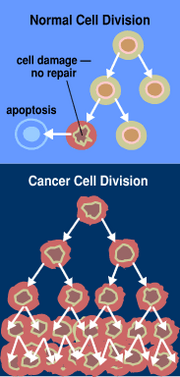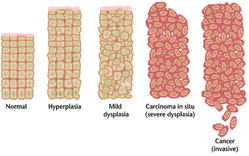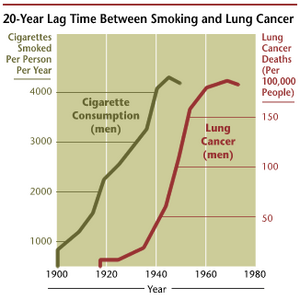1 Most women overestimate their chance of getting breast cancer. In a survey by the Atlanta-based American Cancer Society, nearly half the respondents thought that American women have a 30-50 percent chance of getting breast cancer, and two-thirds thought that the risk was more than 20 percent. Cancer statistics experts say that among girls born in 2005, an estimated 13 percent will develop breast cancer at some time in their lives.
2 Eighty percent of breast lumps are not cancer. Many are simply fibrocystic changes: Sacs in your breast fill with too much fluid and become hard and may be painful. These changes are common among women of childbearing age, and often fluctuate during the menstrual cycle.
Fibroadenomas are benign tumors common among women in their 20s and 30s. There is usually no treatment for them if they do not grow; if they do, some doctors recommend removing them surgically. A malignant tumor tends to feel like a fixed, hard object and is more irregular in shape, says breast surgeon Gregory Senofsky, M.D., author of The Patient's Guide to Outstanding Breast Cancer Care (Perigee, 2002). A benign lump is often more round and moves easily from side to side. All lumps, however, should be checked by your doctor.
3 Doing monthly breast self-exams is always a good idea. "Despite the fact that [research] doesn't statistically show that breast self-exams save lives, I've seen cases where young women are the first ones to pick up a breast mass," says Marleen Meyers, M.D., assistant professor of medicine in oncology at New York University Medical Center in New York City, who encourages all her patients to perform regular self-exams. To see a short video clip about the best way to examine your breasts, visit komen.org/bse.
The American Cancer Society recommends that women 20 and older examine their own breasts every month and that women in their 20s and 30s have their breasts examined by their doctors every three years. Because risk rises with age, women 40 and older should have their breasts examined by a doctor annually and begin getting annual mammograms.
4 About 80 percent of women who get breast cancer have no known risk factors for it. The best way to deal with this is to do what you can to reduce your known risk factors and not worry about what you can't control. Proven lifestyle factors that increase breast-cancer risk are drinking two to five alcoholic drinks per day, being overweight (particularly if the added weight was put on after age 20) and not exercising.
Risk factors that you can't control include being a woman; being older than age 50; having a mother, sister or daughter diagnosed with breast cancer at a young age; being Caucasian; getting your first period before age 12; having one of the two breast-cancer genes; and not having children or having them after age 30. To calculate your own individual estimated risk, try the Breast Cancer Risk Assessment Tool at bcra.nci.nih.gov/brc.
5 You can find out if you carry the breast-cancer gene. But should you? About 211,000 American women will be diagnosed with breast cancer this year, but only 5-10 percent of them are carrying one or more of the inherited altered genes called BRCA1 and BRCA2, according to the Bethesda, Md.-based National Cancer Institute. A woman with one of these altered genes has an 80 percent chance of developing breast cancer sometime in her life.
Getting this test can have repercussions: A positive result could be emotionally difficult for you and your family. You will need to talk to your doctor about more monitoring (e.g., more frequent mammograms) and cancer-prevention choices (taking the drug tamoxifen, for instance, has been shown nearly to halve the number of breast cancers in high-risk women). Plus, a negative result may give you a false sense of security. To learn more about genetic testing or to find a genetic counselor near you, visit the National Society of Genetic Counselors at nsgc.org.
6 Your breast-cancer risk factors should be considered when selecting birth control. Studies are mixed on whether use of oral contraceptives increases breast-cancer risk. (The two kinds of oral contraceptives available in the United States include a combination of estrogen and progesterone and the minipill, which contains the synthetic form of progesterone only.) "Although there is no hard evidence that women who use oral contraceptives have an increased risk of breast cancer, if my patient has a family history of breast cancer or a relative with the breast-cancer genes, I suggest that she find another birth-control method to avoid possibly compounding her risk," Meyers says.
7 Breast size has nothing to do with risk, but height and weight do. Excess weight, not breast size, is a risk factor, particularly in postmenopausal women--and not just for getting breast cancer, but for dying of it. Thirty to 50 percent of all cancer deaths among postmenopausal women in America may be attributed to being overweight, according to the American Cancer Society. Estrogen is stored in fat tissue, so heavier women produce more of the female hormone which can spur developing cancers. And, because breast tumors are harder to detect in obese women, cancer is often found at later stages.
The risk of dying of breast cancer is also associated with height, which may be related to growth factors early in life. Women who are 5 feet tall or shorter are at less risk of death from the disease than those who are taller.
8 Exercise may lower your breast-cancer risk, and will help prevent a recurrence if you do get it. "In premenopausal women, exercisers have lower levels of estrogen and progesterone," says Anne McTiernan, M.D., Ph.D., director of the Prevention Center at Fred Hutchinson Cancer Research Center in Seattle and co-author of Breast Fitness (St. Martin's Press, 2001). Similarly, a woman's cancer risk may be higher if her estrogen level is extended during her lifetime (in other words, if she began menstruating early, had no pregnancies and/or experienced delayed menopause). Progesterone, too, may have an effect, as it was recently discovered that postmenopausal women taking hormone replacement therapy that consisted of synthetic estrogen and progesterone had a higher cancer risk than women who took estrogen only.
Even a small amount of exercise offers protection--one study showed that as little as 1 1/4-2 1/2 hours of brisk walking a week reduced a woman's breast-cancer risk by 18 percent.
9 Having dense breasts when you're older is a risk factor. Women who are 40 or older with dense (highly glandular) breasts do have an increased breast-cancer risk. "There are more lobules and cells that are active in dense breasts than in fatty breasts, and a greater prevalence of cancer in that type of tissue," says Wendie Berg, M.D., Ph.D., a radiologist in Lutherville, Md. Most young women have dense breasts, but as they get older, their breasts become more fatty. Breast density can only be measured on a mammogram, says Berg, who is leading a clinical trial of ultrasound screening for women at high risk for breast cancer.
10 If you have dense breasts or a high risk of getting breast cancer, ultrasound may be used as a supplement to mammograms for screening. Women who have known cancer risk factors, or who are 40 or older with dense breasts, may want to get an ultrasound as well as a mammogram as often as every six months to a year (it's increasingly being covered by insurance), Berg says. "A screening ultrasound has been shown to detect small (1-centimeter), invasive breast cancers not seen on mammography, usually before they have spread to the lymph nodes," she says. "In extremely dense breast tissue, at least half of invasive cancers are not seen on mammography."
NICOLE GREGORY is a writer and editor in Los Angeles who always gets her mammograms on time.
COPYRIGHT 2005 Weider Publications
COPYRIGHT 2005 Gale Group




